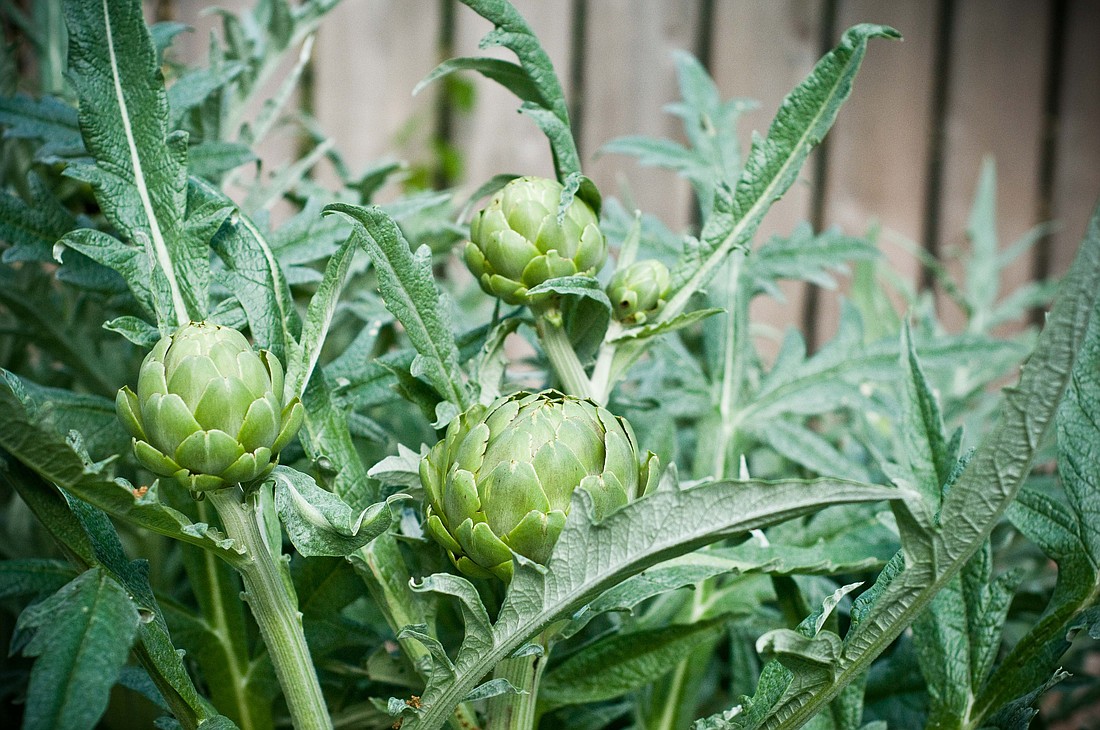Giant thistles: artichokes for the last of summer’s bounty
August 3, 2015 at 11:48 a.m.
Giant thistles about six feet tall are growing in my garden. I have artichokes! Artichokes are one of the vegetables we eat that is really a flower bud, like broccoli or cauliflower. When allowed to flower, the artichoke blossom displays spiky purple petals.
Artichokes are a great source of fiber, folic acid, vitamin C and potassium. To help control our blood pressure, scientists say we need more potassium in our diets, and artichokes are a fun way to get it. Even kids who don’t like vegetables will have fun peeling the leaves off the artichoke bud, dipping them in butter or margarine, and running them between their teeth.
Artichokes will be in the markets now through fall. Those with small white blemishes have been “winter kissed,” and like other vegetables exposed to frost, have a more intense flavor.
The easiest way to cook artichokes is in the microwave. Place in a bowl, cover with plastic wrap and heat for four to six minutes for one artichoke. Add three more minutes for each additional one. Serve with melted butter with fresh minced tarragon leaves mixed in.
You can buy canned marinated artichoke hearts, but they are preserved in oil and salt. For a healthy alternative, rinse them in a colander to remove the fat and sodium, then use them in this Greek salad to celebrate the end of summer’s bounty.
Summer’s End Greek Salad
4-5 ripe Roma tomatoes
1 cucumber
½-1 purple onion
1 green or red pepper
4 ounces feta cheese, cubed
1 small jar marinated artichokes, drained and rinsed
¼ cup fresh basil leaves, chopped fine
¼ cup olive oil
¼ cup fruit-flavored vinegar
Pepper to taste
Cut tomatoes into wedges. Slice cucumber, then quarter the slices. Slice onion very thin and separate rings. Slice peppers into thin strips. Mix all ingredients in a salad bowl. Chill one hour, serve. For dinner, add leftover cooked chicken or flank steak. Serves 4 as a dinner; serves 6 to 8 as a salad.
For an even lower-salt alternative, substitute goat cheese for feta. You’ll cut the sodium down to 150 mg for dinner and 75 mg for a salad-size serving.
Nutritional information (using feta cheese):
Dinner serving: Calories: 240, Carbohydrates: 8 g, Protein: 6 g, Fat: 7 g, Sodium: 450 mg
Side salad serving: Calories: 150, Carbohydrates: 4 g, Protein: 3 g, Fat: 4 g, Sodium: 230 mg
The information in this column is meant for people who want to keep their kidneys healthy and blood pressure down by following a low-sodium diet. In most cases, except for dialysis patients, a diet high in potassium is thought to help lower high blood pressure. These recipes are not intended for people on dialysis without the supervision of a registered dietitian.
Katy G. Wilkens is a registered dietitian and department head at Northwest Kidney Centers. The 2013 recipient of National Kidney Foundation Council on Renal Nutrition’s Susan Knapp Excellence in Education Award, she has a Master of Science degree in nutritional sciences from the University of Washington. See more of her recipes at www.nwkidney.org.





